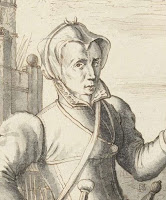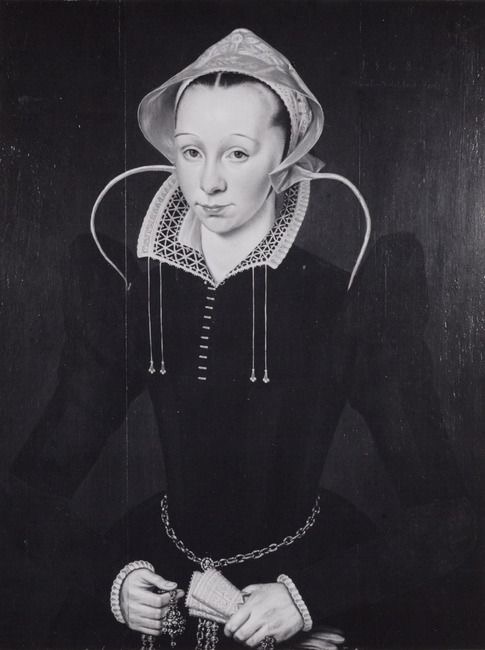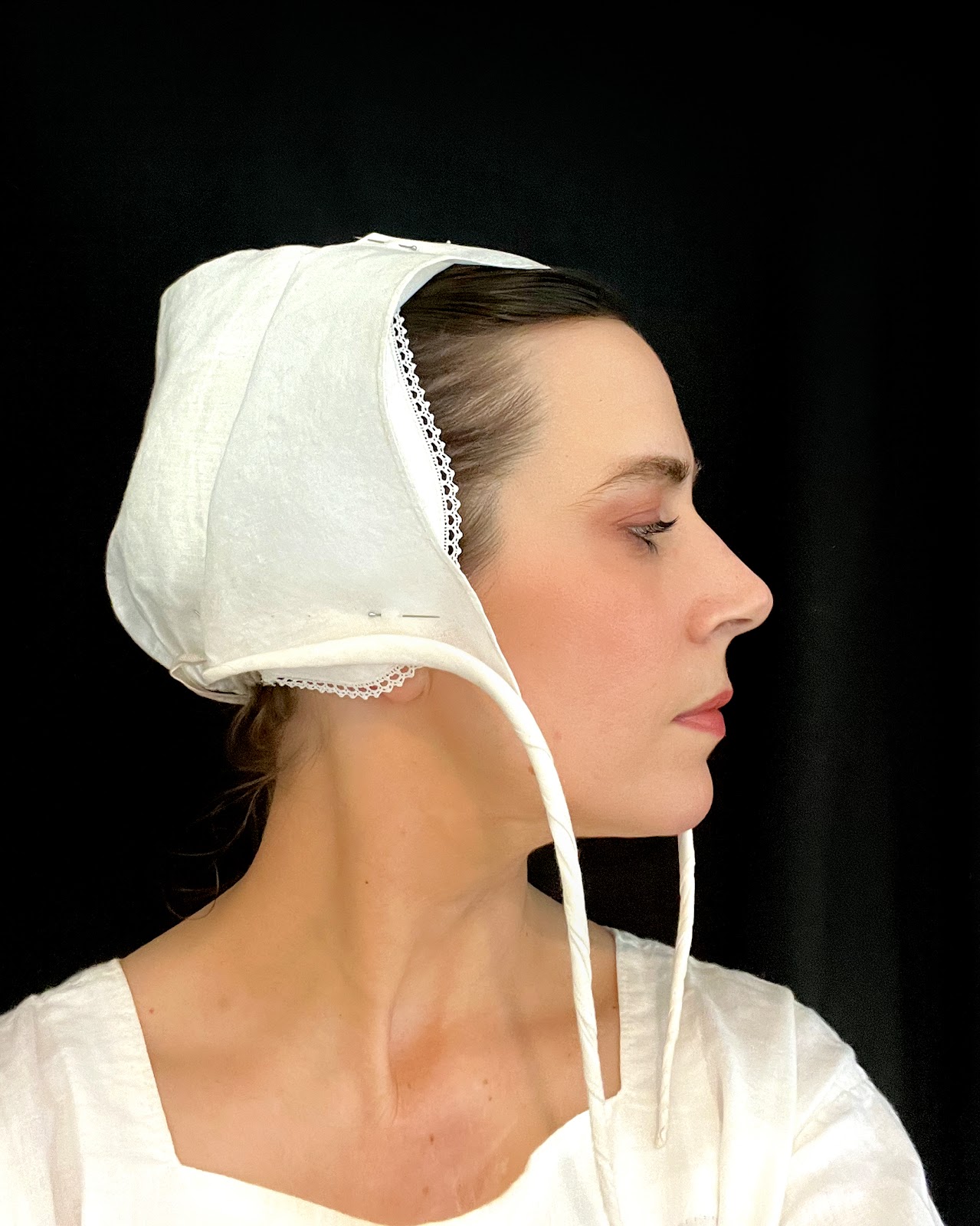***
I was mid write-up on an upcoming post for an outfit inspired by the Dutch folk hero, Kenau Simonsdochter Hasselaer, when I realized this coif needed to be it's own post.
(Please excuse the weird, super wide-angle lens of the iPhone's reverse view)
Let me back up a bit...
As part of my research into my Keanu inspired outfit I hit a stumbling block as to what sort of head covering to make.
She is featured in multiple paintings, etching and pamphlets. While the pose and styling remains fairly consistent across most images, there is one significant point of difference: the coifs (caps? veils?).
She is featured in multiple paintings, etching and pamphlets. While the pose and styling remains fairly consistent across most images, there is one significant point of difference: the coifs (caps? veils?).
Broadly these fall into two categories:
1) Tails tied over the head...
2) Tails down...
What exactly is going on here?
Let's consider the second version with the loose tails (assuming the first is the same but with the ends tied over the head). This style of head-covering is fairly typical of mid to late 16th c. Dutch fashion.
 |
| Pieter Jansz Pourbus, 1550s |
Although to looks like a close fitting coif, it's more probably a very intricately folded veil which evolved from earlier styles.
Now, I'm going to say right out the gate that I have no idea how this was achieved. Zero. None.
I've tried folding your standard rectangular veils and couldn't even get close. I'm not sure if I have the shape wrong or if the fabric just isn't fine enough (and probably both) but it's a non-starter.
There's no way I can (currently) make a rectangular, tailed veil work.
So instead let's take a detour further back in time (just for fun).
The version with the ties above the head is not too dissimilar to the "tailed caps" of the mid 15th century.
This style is fairly popular with reenactors and there are several suggested patterns for its construction. I'm not sure that I'm totally convinced by any of them, but I decided to try a couple and compare the results...just to see if they sparked any ideas.
The first is basically a large trapezoid.
(Which didn't quite fit on my cutting board, but the bottom edge is straight across).
It's a single layer of fine 2.8oz linen. The on-grain edges are turned with a narrow folded hem. The bias edges have a rolled hem.
The narrow side frames the face and the longer points are twisted and tied around the head.
The front is also lightly starched (about 4-6" along the narrow edge).
The result is fun, but the angle around the face doesn't quite match the period images (and in fact seems to fall in the opposite direction)
But it's an attractive shape and can be worn in multiple different ways.
Next is a long rectangle with a large 'V' cut out of one end.
Again, the tails are twisted and tied on top of the head.
The front section is also starched (a bit more heavily this time) as well as being folded down the middle. This helps create the heart shape that frames the face.
It still doesn't quite mach the mid 15th c. silhouette above, but it is a closer match for the later 16th c. styles (and so more in the ballpark for what I'm ultimately aiming for).
This can also be pinned to the under coif to create different silhouettes.
And of course it can also we worn down as a long, split-tailed veil.
While both patterns (and all the variants) are super fun to wear I'm still not 100% convinced by either version, if only for the inefficient use of fabric (and resulting wastage).
So I'm back to square one.
Really, I'm in a position where I'm fairly certain that anything I do will be wrong (historically) so now it's just a matter of picking something that works aesthetically and/or theatrically.
So I start thinking about abandoning the veil and making a coif.
Conveniently, this is also when I discover this image:
Motivated reasoning aside, the image does seem to suggest gathers at the nape of the neck and the tails coming off the front brim (rather than from behind).
It's not a total leap. There are early 17th c. coifs that feature long tails, though they don't particularly lend themselves to be twisted in this style.
(Hello again, motivated reasoning! I missed you! Come, pull up a chair. Stay a while...)
So with that in mind I decided to adapt the late 16th/early 17th c. coif pattern I've made up previously.
 |
| (NOTE: This pattern is given in centimeters, the previous patterns are in inches) |
The linen pattern is cut in light weight linen. Wherever possible a tread is pulled so that the all edges are cut exactly on the grain (basically everything except the tapered, diagonal edge)
All edges are then finished with a narrow turned hem (except the diagonal egde, for which I found it easier to to do a rolled hem)
Then back edges are whipstitched together (right sides facing)
The coif is now complete!
Now it's time to shape it...
First, the front section is starched, folded down the middle and pressed to create a heart shape to frame the face.
(The coif is pressed inside out, so that when flipped the top springs outwards from the central fold)
Next, the tails are twisted to form tight "barbels" (as they are lovingly referred to on the Elizabethan Costuming FB Page).
It's a tad difficult to see, but the brim is also folded back over itself (just where the ties wrap around the head) in order to encourage it to spring out and upwards.
The cap can then be pinned to create subtly different shapes.
Flat across the top:
Heart shaped:
Or even that baffling style where the tails form a ring.
And....I think that's about it!
Phew!
For what was meant to brief side post, this ended up pretty packed.
I should also note that all of the above styles are worn over a close fitting coif...
...but for the most part I didn't use my ear irons (or 'oorijzers').
 |
| (Oooh...look at her, she's a baby! Back when you still took photos with cameras.) |
Usually I use oorijzers to help stabilize my starched caps and veils, but found that most styles worked well enough just pinned to the under coif.
I did however use ear irons for these two images.
(While I found they did help anchor the coif they were not strictly necessary to achieve a similar look. Having said that, I will probably still opt for them when wear this style out of doors and need to account for the wind.)
Final thoughts: After all that I still don't think I've gotten much closer to figuring out what's really behind these styles, but it was fun and informative to compare the various shapes and silhouettes.
At the very least I've got a couple of good options for my Keanu outfit...which was, after all, the whole point.
Hopefully I can get the full post up soon!
(EDIT: And HERE it is!)
***
Resources & Materials
Pattern:
-Veils: self drafted/draped
-Coif: The Marquess of Winchester Coif #4 (with significant edits)
Fabric:
-White linen (2.8oz) from WM Booth Draper
Trim and Notions:
-Linen tape (1/4") for lacing from WM Booth Draper
Thread:
-White cotton thread (silk finish)















































































Thank you so much for your research! Fabulous!
ReplyDeleteIncredibly creative! I loved your exploration
ReplyDeleteYou look so pretty
ReplyDelete